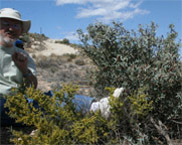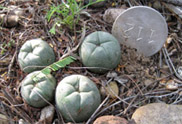 Impact of the Peyote (Lophophora williamsii) Trade on Endangered Star Cactus (Astrophytum asterias) Dana M. Price, Wildlife Diversity Branch, Texas Parks and Wildlife Department, Austin, TX 78704 Martin Terry, Department of Biology, Texas A&M University, College Station, TX 77843 Abstract Star cactus, Astrophytum asterias (Zuccarini) Lemaire (Cactaceae), [Fig. 1] is a federally listed endangered cactus endemic to the Tamaulipan thornscrub ecoregion of extreme southern Texas, USA, and Tamaulipas and Nuevo Leon, Mexico. Only two subpopulations totaling about 2,000 plants are presently known in Texas. Star cactus, known locally as "star peyote", is highly prized by collectors. This small, dome-shaped cactus is spineless and thus is sometimes mistaken for peyote (Lophophora williamsii), which grows in the same or adjacent habitats. Peyote is harvested from native thornscrub habitats in Texas by local Hispanic people and sold to peyoteros, licensed distributors who sell the peyote to Native American Church members. Annual peyote harvests in Texas approach 2,000,000 "buttons" (crowns). Although the peyoteros do not buy star cactus from harvesters, they cultivate star cactus in peyote gardens at their places of business and give star cacti to their customers as lagniappe. If even 0.1% of harvested peyote is actually star cactus, the annual take of this endangered cactus approaches the total number of wild specimens known in the U.S. This unverifiable but plausible threat, plus other data from interviews with local residents, suggests the existence of many more star cactus populations than have been documented.  Figure 1. Endangered Astrophytum asterias (star cactus), Starr County, Texas II. Range and habitat of Astrophytum and Lophophora III. Commercial Peyote Harvest – How It Works IV. Incidental harvest of star cactus with Peyote: Problem or Opportunity? Acknowledgements Literature Cited All images © are copyrighted by the photographers and/or the CCI and are used with permission. Reproduction is forbidden without prior written consent. Cactus
Conservation
Institute
|










